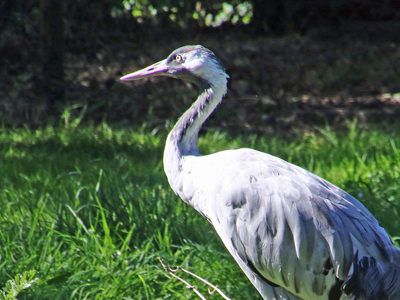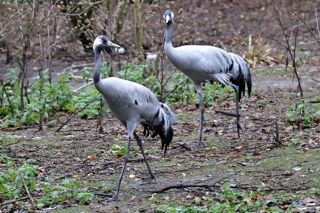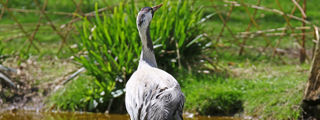
Eurasian/Common Crane
Grus grus
Standing at around 130cm tall, with a wingspan of around 220-245cm and weighing between 4-7kg, the Common Crane is a medium-sized crane. Grey in colour, with adults having a red patch on their head. Long slender legs with a long sharp bill.
Habitat
Breeding habitats include shallow wetlands, moors, reed marshes, swampy forest clearings and rice paddies. Wintering habitats normally include flood land, swampy meadows or mudflats and pastures.
Behaviour
Form monogamous pair bonds, only attempting to attract another mate if one of the pair dies. Still go through their courtship rituals each spring; known as “dancing”. The dance that each crane with perform for the other includes bobs, bows, and pirouettes. Social bird, forming flocks of up to 400 during migration.
UK Status
Common cranes were widespread breeders up to the 1600s in the UK. Habitat loss mainly due to wetland drainage and hunting means they were driven to extinction.
In the 1970’s, a small population recolonised the Norfolk Broads. Being a very vulnerable, small population, successful recovery to the UK would only happen with help. RSPB’s 'The Great Crane Project' works on reintroducing common cranes to the South west of England (highlighted as the best potential habitat) in the hopes of restoring a healthy population to the UK.

Distribution
Found across Europe and Asia. Breeding populations restricted to northern Europe, particularly Russia. In autumn, many migrate to their wintering grounds in northern Africa and southern Asia, although some have been known to winter in southern Europe (e.g. Portugal and Spain).
Diet
Like all cranes, the Common rane is omnivorous. The plant material portion of its diet consists of roots, rhizomes, leaves, fruits, seeds, nuts and acorns. During the breeding season, they rely more heavily on animal food sources such as insects, snails, crabs, spiders, amphibians, rodents and other small birds.
Threats
Habitat loss is a major threat across its range, through urbanisation, dam construction, and agricultural practices. Nest disturbance of the breeding population by tourism and recreation has also been shown to impact numbers. Collision with power lines and hunting are notable threats during migration.
Wildwood inside information
Our walkthrough aviary is home to a pair of cranes, affectionately known as Fred (Astaire) and Ginger (Rogers) in homage to their beautiful dancing courtship rituals.
Family facts
Common cranes have been known to fly at altitudes of up to 33,000ft (10,000m), one of the highest of any species of bird, second only to the Ruppell’s Griffin Vulture.


